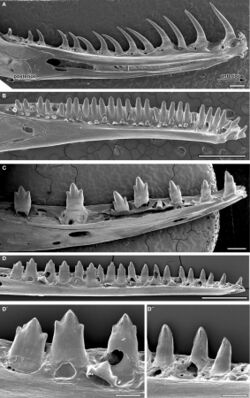Biology:Heterodont
From HandWiki
Short description: Animals which have more than a single tooth morphology

In anatomy, a heterodont (from Greek, meaning 'different teeth') is an animal which possesses more than a single tooth morphology.[2][3]
In vertebrates, heterodont pertains to animals where teeth are differentiated into different forms. For example, members of the Synapsida generally possess incisors, canines ("dogteeth"), premolars, and molars. The presence of heterodont dentition is evidence of some degree of feeding and or hunting specialization in a species. In contrast, homodont or isodont dentition refers to a set of teeth that possess the same tooth morphology.
In invertebrates, the term heterodont refers to a condition where teeth of differing sizes occur in the hinge plate, a part of the Bivalvia.[2]
References
- ↑ Zahradnicek, Oldrich; Buchtova, Marcela; Dosedelova, Hana; Tucker, Abigail S. (2014). "The development of complex tooth shape in reptiles". Frontiers in Physiology 5: 74. doi:10.3389/fphys.2014.00074. PMID 24611053. 50px Material was copied from this source, which is available under a Creative Commons Attribution-ShareAlike 3.0 Unported license.
- ↑ 2.0 2.1 A Dictionary of Earth Sciences. Encyclopedia.com. 10 October 2017. http://www.encyclopedia.com/plants-and-animals/zoology-and-veterinary-medicine/zoology-general/heterodont.
- ↑ Tanika, M (22 July 2016). "Dentition in Mammals: Definition, Origin, Types and Unusual Teeth in Mammals". http://www.biologydiscussion.com/zoology/mammals/dentition-in-mammals-definition-origin-types-and-unusual-teeth-in-mammals/41558.
See also
- Diphodonty
 |

